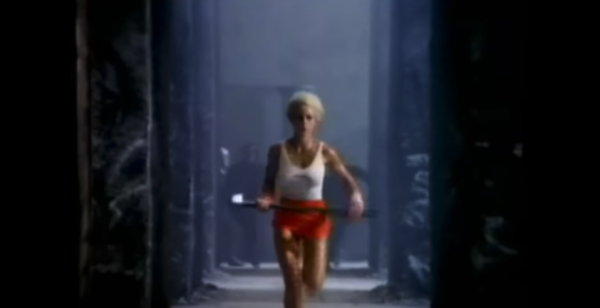
© Apple. “1984” is an American television commercial that introduced the Apple Macintosh personal computer.
Has Super Bowl advertising jumped the shark?
As way of explanation, here’s the definition of “Jump the shark”:
“Jumping the shark is the moment when something that was once popular no longer warrants the attention it previously received, particularly when attempts at publicity only serve to highlight its irrelevance… reaching a point at which far-fetched events are included merely for the sake of novelty, indicative of a decline in quality.”
Sounds an awful lot like the current state of Super Bowl advertising.
What’s the last great, memorable, Super Bowl ad you can recall?
The memorable gems are getting fewer and farther between. Some of the all-time greats include Monster.com “When I grow up,” Chrysler’s “Imported from Detroit,” Google’s “Parisian Love,” and of course, Apple’s “1984.” Every one of these spots touched an emotional nerve and made a strong connection with the brand’s audience. They could run today and still be relevant. They weren’t advertising for the pure sake of entertainment, but in the service of selling.
Amazon Alexa losing her voice? The Bud Light Bud Knight? Mr. Clean, Cleaner of Your Dreams? None of these will be remembered in five years; hell, you can’t recall many of them now. Year after year, Super Bowl advertising gets more and more mediocre. Marketers are out to make a Super Bowl spot, and have gotten the fundamental elements of making great advertising:
Make it interesting. Make it relevant. Make it emotional (and yes, humor is an emotion.) And most important, make it sell.
That’s the key point that gets lost in the excitement and pressure of creating a commercial that is going to run on the Super Bowl. With 30 seconds of air time selling for more than $5 million, how do we end up with the morass of crap that passes for advertising on what is ostensibly the greatest advertising vehicle on the planet?
The simplest answer is that it’s the single greatest advertising vehicle on the planet. And fear of failure causes us to lose our marketing common sense. Marketers tend to swing to one of a few extremes:
- committee-think, with layer after layer of approvals and feedback and notes until the final product offends no one, and also connects with no one. Case in point is this year’s Budweiser spot, “Wind never felt better” – a hodgepodge of elements, each carefully pretested into an olio that ticks all the boxes – Clydesdales? Check. Dalmatian? Check. Fields of golden grain? Check. Boomer-friendly classic song? Check. Purpose-driven subtext? Check. Everything’s accounted for, but there’s no room left for an authentic emotion or selling message.
- alternatively, the brave CMO closes his eyes and entrusts a wacky young creative team who are trying to impress their friends. This year’s “Food porn” from Devour frozen dinners fits this bill. Funny, yes, but does it sell?
- even worse, the CEO writes his own commercial, because, well, he’s all-powerful and all-knowing, with disastrous results. Exhibit a: SalesGenie.com’s CEO conceived and scripted his own overtly racist, amateurish ads two years in a row, to universal disdain. Let’s hope this trend is dead and buried.
Coming back to the argument that Super Bowl advertising has jumped the shark, let’s look at the last part of the definition – “a point at which far-fetched events are included merely for the sake of novelty, indicative of a decline in quality.”
So far this year, we have random celebrities (Michael Bublé, Cardi B, Steve Carrell, Harrison Ford, Sarah Jessica Parker and Jeff Bridges), robots, mermaids, signing dogs, porn addiction… little of which has anything to do with selling the product and everything with being included for the sake of novelty.
All grousing and complaining aside, I’m hoping to be pleasantly surprised and look forward to seeing the Super Bowl ads actually make a comeback. After all, Ron Howard and Henry Winkler did pretty well after their shark-jumping* days.
*I was surprised at how many people in the office didn’t understand this reference. Has “jumped the shark” jumped the shark?



